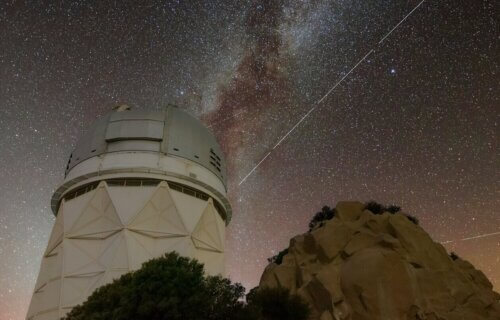LONDON — Although they may keep your smartphones working, giant communication satellites and various pieces of space junk in low-Earth orbit could end up obstructing our view of astronomical marvels out in space. Researchers from Imperial College London note that these massive structures orbiting the globe may impede our understanding of the universe.
An international research team discovered that the BlueWalker 3 satellite, for instance, is one of the most luminous objects in the nighttime sky, rivaling the brightness of the brightest stars.
As companies continue to develop “constellations” consisting of potentially hundreds of satellites to provide global mobile and broadband services, astronomers worry about the negative implications for stargazing. These sizable satellites, positioned in low-Earth orbit, could especially obstruct visual and radio astronomical observations.
Researchers from the IAU Centre for the Protection of the Dark and Quiet Sky from Satellite Constellation Interference (CPS), which includes experts from Imperial College London, closely examined the impact of the BlueWalker 3 satellite.

“The night sky is a unique laboratory that allows scientists to conduct experiments that cannot be done in terrestrial laboratories,” says Dr. Dave Clements, a physicist at Imperial, in a media release. “The pristine night sky is also an important part of humanity’s shared cultural heritage and should be protected for society at large and for future generations.”
AST SpaceMobile launched BlueWalker 3, a prototype for a constellation of over a hundred similar satellites aimed at enhancing mobile communication, into low-Earth orbit on Sept. 10, 2022. Shortly after, the satellite was identified as one of the night sky’s brightest entities. The CPS assembled a global team of astronomers to monitor the satellite, documenting its unprecedented brightness for over 130 days. Notably, the satellite’s brightness surged dramatically after deploying its 64-square-meter antenna, the most expansive commercial antenna system ever sent to low-Earth orbit.
Tracking satellites is crucial for astronomers to either sidestep them or anticipate their location. Yet, evading the brightest ones poses challenges, typically necessitating the obscuring of the satellite’s position, which compromises the observational data.
Radio astronomy is at risk as well, given that BlueWalker 3 operates at wavelengths proximate to those utilized by radio telescopes. Many of these telescopes are situated within designated “radio quiet” areas, but these zones only restrict ground-based transmitters, granting satellites free rein.
“BlueWalker 3 actively transmits at radio frequencies that are close to bands reserved for radio astronomy, and existing observatory protections from radio interference may not be sufficient,” says Dr. Mike Peel, co-head of IAU CPS’s Sathub and a physicist at Imperial. “Further research is therefore required to develop strategies for protecting existing and upcoming telescopes from the numerous satellites planned for launch over the next decade.”
The study is published in the journal Nature.
You might also be interested in:
- Explosion in space satellite traffic may pose a bigger threat than plastic pollution
- Fearsome new U.S. Space Force squadron gets their first adversary — enemy satellites
- Can aliens detect us? Earth’s growing radio traffic is making it possible
South West News Service writer Pol Allingham contributed to this report.

